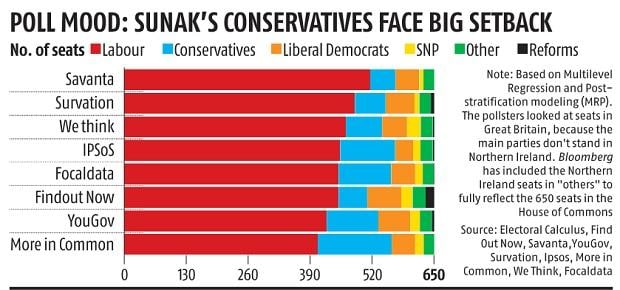Voting begins at UK ballot boxes; Rishi Sunak’s future as PM hangs in the balance
THURSDAY, JULY 4, 2024 British Prime Minister Rishi Sunak and his wife Akshata Murty arrive at a polling station to cast their votes near Richmond, North Yorkshire, England. (Photo: PTI)
Rishi Sunak’s future as Britain’s prime minister and leader of the Conservative Party hangs in the balance as polls open across the United Kingdom on Thursday. The leader of British India and the man who aspires to his job, Keir Starmer, is out early today to cast his vote, along with millions of others across the country.
Sunak and his wife Akshata Murty walked hand-in-hand to their local polling station on a sunny day in his constituency of Richmond and Northallerton in Yorkshire, northern England. Moments later, Starmer and his wife Victoria were at their polling station in Camden, north London, dressed in Labour’s red colours.
As is usual in the UK, there is no campaigning or party political campaigning at polls.
Sunak, 44, is battling voter fears about the incumbent Conservative Party after 14 years in power, having already struggled to stay behind the 61-year-old Labour Party, led by Keir Starmer, during the six-week campaign.
Both leaders ended their polls with contrasting messages. Sunak urged voters not to give the “tax-raising” Labour Party a “supermajority”, while Starmer played down the chances of a landslide victory, fearing that a low turnout would sway the final result.
Candidates are being put forward for 650 constituencies in England, Scotland, Wales and Northern Ireland. For a majority in the first past the post system, 326 candidates are needed.
In addition to the two main parties, voters can choose from a list of candidates representing the Liberal Democrats, the Green Party, the Scottish National Party (SNP), the SDLP, the Democratic Unionist Party (DUP), Sinn Fien, Plaid Cymru, the anti-immigration Reform Party and several independent candidates.
Around 7 a.m. local time, some 40,000 polling stations opened across the country. An estimated 46 million registered voters went outside to put a cross next to their chosen candidate on a paper ballot.
Since this year, it has been mandatory to take an identification document to the polling station at elections in the UK, which are open to all registered adult voters resident in the UK, including Indians as Commonwealth citizens. Several voters have already cast their votes in a postal ballot, which can also be returned to their local councils if it is still being processed.
Once the votes have been cast and the polling stations officially close at 10pm local time, the focus shifts to the final exit poll which will shortly thereafter give a fair picture of what can be expected in the UK. Counting begins immediately across the country, with the first results expected just before midnight local time.
“Stop the Labour supermajority” was the central message British Prime Minister Sunak tried to convey at the end of his campaign, even though most incumbent Conservatives had all but conceded defeat in the general election.
“Labour will raise your taxes. Again and again and again,” Sunak posted on social media as the all-encompassing message to close the campaign.
The strategy of the British-Indian leader and his team in the final hours was to mobilize their traditional voters to close the gap of a widely expected defeat after clear Tory majorities in the last three general elections. The opposition called it scare tactics to stir up Tory voters, hoping to preserve the Labour majority below that won by former Prime Minister Tony Blair, the Labour Party in 1997, with 179 seats.
The Labour Party, meanwhile, was keen to brush aside the message of its victory as a foregone conclusion in order to combat complacency within the party and among its own voter base.
“The job is not done yet,” Starmer warned.
Pollsters have predicted a low turnout. The last general election in December 2019 saw a turnout of 67 percent, with Johnson winning a solid majority with his message of “Get Brexit Done.”
If the polls are to be believed, the incumbent Tories are poised to win somewhere between 53 and 150 seats, while Labour is expected to win a landslide. This will result in Starmer taking over as Prime Minister, the first Labour leader since Gordon Brown to enter 10 Downing Street since 2010.
The last general election was held in December 2019, when Boris Johnson won 365 seats, giving him a majority of 80. Labour won 202 seats, the Scottish National Party (SNP) 48, the Liberal Democrats 11, the Democratic Unionist Party (DUP) eight, Sinn Fein seven, Plaid Cymru four, the SDLP two, the Alliance Party one and the Greens one.
The UK has a five-year election cycle and Sunak had until January 2025 to go to the polls, but he opted for a surprise election in the summer, setting a date of July 4 in May.
It is the first time he has sought a mandate from voters after being elected leader of the Conservative Party by party members in October 2022, making him Britain’s first Indian-born prime minister. It is also the first test at the ballot box for Starmer, who took over from Jeremy Corbyn after Labour’s defeat in 2019.

(Only the headline and image of this report may have been edited by Business Standard staff; the rest of the content is auto-generated from a syndicated feed.)
First print: 05 Jul 2024 | 01:04 IST
